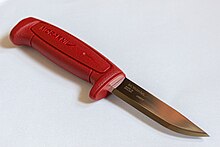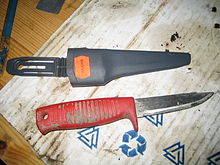
A knife is a tool or weapon with a cutting edge or blade, usually attached to a handle or hilt. One of the earliest tools used by humanity, knives appeared at least 2.5 million years ago, as evidenced by the Oldowan tools. Originally made of wood, bone, and stone, over the centuries, in step with improvements in both metallurgy and manufacturing, knife blades have been made from copper, bronze, iron, steel, ceramic, and titanium. Most modern knives have either fixed or folding blades; blade patterns and styles vary by maker and country of origin.
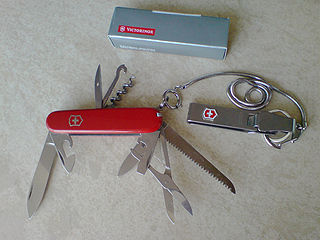
The Swiss Army knife (SAK) is a pocketknife, generally multi-tooled, now manufactured by Victorinox. The term "Swiss Army knife" was coined by American soldiers after World War II after they had trouble pronouncing the German word "Offiziersmesser", meaning "officer’s knife".

A Japanese kitchen knife is a type of kitchen knife used for food preparation. These knives come in many different varieties and are often made using traditional Japanese blacksmithing techniques. They can be made from stainless steel, or hagane, which is the same kind of steel used to make Japanese swords. Most knives are referred to as hōchō or the variation -bōchō in compound words but can have other names including -kiri. There are four general categories used to distinguish the Japanese knife designs: handle, blade grind, steel, and construction.
A puukko is a small traditional Finnish general purpose belt knife with a single curved cutting edge, solid hidden tang, and usually, a flat spine. Military models of puukko were popular in the Russian criminal underworld under the name "Finnish knife" or finka since the 20th century. The modified version were among the models on which the Soviet military knife NR-40 was based and which was informally called "finka".
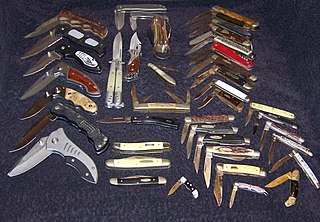
A pocketknife is a knife with one or more blades that fold into the handle. They are also known as jackknives (jack-knife), folding knives, EDC knife, or may be referred to as a penknife, though a penknife may also be a specific kind of pocketknife. A typical blade length is 5 to 15 centimetres.

The Opinel company has manufactured and marketed a line of eponymous wooden-handled knives since 1890 from its headquarters in Saint-Jean-de-Maurienne, Savoie, France where the family-run company also operates a museum dedicated to its knives. The company sells approximately 15 million knives annually. Opinel knives are made of both high carbon and stainless steel, the latter being Sandvik steel from Sweden.
The Laguiole knife is a traditional Occitan pocketknife, originally produced in the "knife city" of Thiers, source of 70% of France's cutting tool production, as well as the small village of Laguiole, both located in the Massif central region of France. Laguiole in this instance does not refer to the French knife brand but to a generic type of traditional slipjoint knife associated with this region of France.

A kitchen knife is any knife that is intended to be used in food preparation. While much of this work can be accomplished with a few general-purpose knives – notably a large chef's knife, a tough cleaver, a small paring knife and some sort of serrated blade – there are also many specialized knives that are designed for specific tasks. Kitchen knives can be made from several different materials.
In cooking, a chef's knife, also known as a cook's knife, is a cutting tool used in food preparation. The chef's knife was originally designed primarily to slice and disjoint large cuts of beef. Today it is the primary general-utility knife for most Western cooks.
Spyderco is an American cutlery company based in Golden, Colorado, producing knives and knife sharpeners. Spyderco pioneered many features that are now common in folding knives, including the pocket clip, serrations, and the opening hole. Spyderco has collaborated with 30 custom knife makers, athletes, and self-defense instructors for designs and innovated the usage of 20 different blade materials.

Knife making is the process of manufacturing a knife by any one or a combination of processes: stock removal, forging to shape, welded lamination or investment cast. Typical metals used come from the carbon steel, tool, or stainless steel families. Primitive knives have been made from bronze, copper, brass, iron, obsidian, and flint.

GLOBAL is a Japanese brand of kitchen knives and accessory tools owned and manufactured by the Yoshikin factory of Japan. The Yoshikin Factory is owned by the Watanabe family and located in Tsubame, Japan.

Cold Steel, Inc., is an American retailer of knives/bladed tools, training weapons, swords and other martial arts edged and blunt weapons. Founded in Ventura, California, the company is currently based in Irving, Texas, after an acquisition by GSM Outdoors in 2020. Cold Steel products are manufactured worldwide, including in the United States, Japan, Taiwan, India, Italy, China, and South Africa.
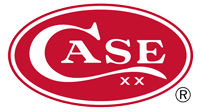
W.R. Case & Sons Cutlery Company is an American manufacturer of traditional pocket knives, fixed blades/sporting knives, kitchen knives, limited edition commemoratives and collectibles. The company originated in Little Valley, New York, around the turn of the 20th century, before relocating to its current home, Bradford, Pennsylvania, in 1905. The company's namesake, William Russell Case, first made knives with his brothers under the name Case Brothers Cutlery Company. His son, John Russell ("Russ") Case, worked as a salesman for his father's company before founding W.R. Case & Sons.

The Okapi is a ratchet-lock clasp or slipjoint knife originally produced in 1902 for export to Germany's colonies in Africa. The knife takes its name from the giraffe-like central African okapi.

SHARPFINGER® is a brand of knife modeled after the Schrade 152 OT. The SHARPFINGER trademark is designated to a variety of knives in this design by a number of makers.
Chris Reeve Knives is an American knife manufacturing corporation with international sales and distribution headquartered in Boise, Idaho, that designs, develops, and sells folding pocket knives and fixed-blade knives. Its products include the Sebenza, Inkosi, Umnumzaan, TiLock, Mnandi folding knives, Impinda slip joint, and the Green Beret, Pacific, Professional Soldier, Nyala, and Sikayo fixed blade knives. Chris Reeve Knives' industry contributions include the Integral Lock, contributions to the blade steels CPM-S30V and CPM-S35VN, and has won Blade Magazine's Blade Show Manufacturing Quality Award 15 times. Their motto is Think Twice, Cut Once.

A table knife is an item of cutlery with a single cutting edge, and a blunt end – part of a table setting. Table knives are typically of moderate sharpness only, designed to cut prepared and cooked food.

A steak knife is a sharp table knife designed to efficiently and effectively cut steak. This type of knife comes in a variety of styles and sizes; however, the design often used in a steakhouse typically features a partially serrated blade and wood handle.
